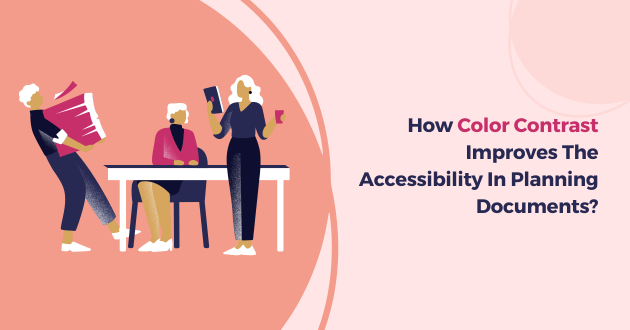
Do you recall the glossy writing on light backgrounds and incomprehensible script fonts common on websites in the 1990s and early 2000s? Sadly, such websites still exist today and are not relics of the past. These websites have a problem with color contrast, which makes the text unreadable. Inadequate color contrast might make it difficult for users to interpret the content on a webpage, even if they have normal vision.
Students learn about color contrast and accessibility in school. Because of how they contrast, some colors may not work well on a website, even if they seem nice next to each other. The difference in brightness between text and background components is called color contrast.
The greatest way to make website text stand out and be simple to read is to use high-contrast colors for both the backdrop and text. It will be difficult to distinguish the text from the backdrop when the colors have low contrast. Examples of color combinations that contrast include black and white or purple and yellow. Viewers can easily see and perceive the difference between these hues.
Why Is Contrast In Color Important?
As color contrast and accessibility may affect how readers engage with written information, color contrast is significant. When text contrasts poorly with backdrop colors, low-contrast colors are hard to read; in comparison, high-contrast colors are easier to read when combined.
A person with color deficiency finds it more difficult to differentiate between yellow, red, and green hues. This implies that they could only be able to distinguish between different colors and read text with high contrast.
Enhanced Legibility:
High coloration comparison between textual content and background ensures that the text is without problems distinguishable, making it simpler for people with visual impairments to read the content of making plans documents.
Improved Visibility:
A color contrast and accessibility makes crucial information, inclusive of headings, bullet factors, or key data, stand out prominently, permitting all readers to fast locate and recognize the crucial factors of the file.
Increased Readability:
Proper coloration contrast reduces eye strain and fatigue, improving the overall analyzing experience for all customers, such as people with visible challenges. This can result in improved comprehension and retention of the file's content.
Accessibility Compliance:
Adhering to shade evaluation standards and hints guarantees that planning files meet accessibility necessities, along with the ones mentioned within the Web Content Accessibility Guidelines (WCAG), making them on hand to a much wider target market, together with human beings with disabilities.
Inclusivity:
By prioritizing color assessment, planning files emerge as greater inclusive and alluring to individuals with various visual abilities, ensuring equitable get entry to essential data and participation in making plans procedures.
Clarity Of Information:
Proper color evaluation allows for the differentiation of diverse factors within the file, consisting of textual content, charts, graphs, and pics, ensuring that all readers understand and interpret each factor effectively.
Facilitation Of Navigation:
Clear colouration comparison aids in the navigation of planning files, supports customers in navigating through sections, headings, and subheadings without difficulty, and facilitates efficient data retrieval and comprehension.
Universal Design:
Implementing robust shade assessment ideas in making plans documents displays a dedication to universal design standards, which the goal to create products and environments which might be handy and usable by way of people of all talents without the want for adaptation or specialized layout.
Contact us at https://www.acadecraft.com/contact-us/ to learn more about Acadecraft's Color Contrast and Accessibility Services.
How Can I Tell If My Color Selections For Contrast Are Ideal?
It's not always simple to determine from a webpage's appearance whether color contrast issues exist. While the content seems great, someone else may find it difficult to read. The specific standards for acceptable contrast ratios on web pages are provided by WCAG 2.1. To achieve WCAG 2.1 Level AA, the W3C group recommends the following color contrast rules. The contrast ratio of typical text and pictures should be at least 4.5:1.
- Large Text: These require a minimum of a 3:1 contrast ratio. The WCAG defines this as a font size greater than 18 points or a bold 14-point typeface.
- Text or pictures used for decoration: These elements don't need to be contrasted since they are hidden or contain other visual elements.
- Logotypes: There is no need for color contrast and accessibility regarding text included in a logo.
Conclusion
Make that your website meets the color accessibility criteria. Ensuring that your material is available to everybody is contingent upon making your website accessible. While there are numerous factors to consider when developing a website, you will benefit in the long run if you design it with strict adherence to the WCAG requirements, both present and future.
These accommodations will be more crucial as more people get older and need them to be able to access the internet without difficulty. Another easy technique to assist your visitors is to update the color contrast on your website. They are, after all, the main justification for having a website!



























